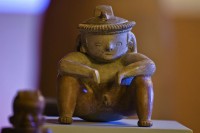 A trove of 691 pre-Colombian artifacts seized by the Spanish police in a 2003 drug raid has finally been repatriated to Colombia after more than a decade of legal limbo. It’s one of the largest lots of illegally exported artifacts ever returned to Colombia, and it’s of inestimable value because of the breadth of cultures, periods and artistic styles represented. There are examples from all of the major civilizations to have flourished in Colombia over the course of 10 centuries before the arrival of the Spanish.
A trove of 691 pre-Colombian artifacts seized by the Spanish police in a 2003 drug raid has finally been repatriated to Colombia after more than a decade of legal limbo. It’s one of the largest lots of illegally exported artifacts ever returned to Colombia, and it’s of inestimable value because of the breadth of cultures, periods and artistic styles represented. There are examples from all of the major civilizations to have flourished in Colombia over the course of 10 centuries before the arrival of the Spanish.
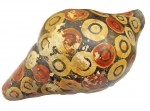 Eighty percent of the artifacts are clay pieces smaller than 12 inches high. These small pieces are disproportionately significant because there are very few examples in the warehouses of the Colombian Institute of Anthropology and History (ICANH), the National Museum of Colombia or in the collections of the archaeological parks of St. Augustine and Tierradentro. The other 20% are larger pieces including funerary urns and vases from St. Augustine, anthropomorphic figures, faces and masks from the archaeological site of Tumaco, ocarinas, whistles and other musical instruments shaped like snail shells from the Nariño region, whistles from Tayrona, ceramic vessels and bowls from the Calima region, stamps, rollers and human figurines from the Quimbaya area, metal votive objects (tunjos) from the Muisca culture, and an unusual collection of tubular glasses and ceramics from Tolima.
Eighty percent of the artifacts are clay pieces smaller than 12 inches high. These small pieces are disproportionately significant because there are very few examples in the warehouses of the Colombian Institute of Anthropology and History (ICANH), the National Museum of Colombia or in the collections of the archaeological parks of St. Augustine and Tierradentro. The other 20% are larger pieces including funerary urns and vases from St. Augustine, anthropomorphic figures, faces and masks from the archaeological site of Tumaco, ocarinas, whistles and other musical instruments shaped like snail shells from the Nariño region, whistles from Tayrona, ceramic vessels and bowls from the Calima region, stamps, rollers and human figurines from the Quimbaya area, metal votive objects (tunjos) from the Muisca culture, and an unusual collection of tubular glasses and ceramics from Tolima.
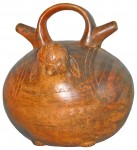 These treasures were part of a group of 894 artifacts from different countries confiscated 11 years ago in Operation Florence, a police operation against drug cartels and money laundering. The authorities gave the artifacts to the Museum of the Americas in Madrid for proper safekeeping. Space was made for the vast collection in the museum stores with constant climate control and high security. The museum director and his team of experts began cataloging and conserving the pieces in 2005. The process of identifying each artifact and determining a place of origin took years.
These treasures were part of a group of 894 artifacts from different countries confiscated 11 years ago in Operation Florence, a police operation against drug cartels and money laundering. The authorities gave the artifacts to the Museum of the Americas in Madrid for proper safekeeping. Space was made for the vast collection in the museum stores with constant climate control and high security. The museum director and his team of experts began cataloging and conserving the pieces in 2005. The process of identifying each artifact and determining a place of origin took years.
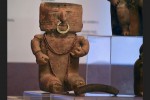 When careful analysis proved that the bulk of the collection came from Colombia, the museum informed the Spanish Police who in turn notified the Colombian Embassy. That was in 2011. The artifacts weren’t immediately returned because it wasn’t clear who owned them. Apparently they were smuggled out of Colombia by a man who laundered money for drug cartels. They don’t appear to have been stolen from museums or archaeological sites, not that anyone can prove, at any rate, so there was some question of whether a previous legitimate owner should get them back or if, as confiscated proceeds of illegal activity they were now property of the state under Spain’s version of asset forfeiture laws.
When careful analysis proved that the bulk of the collection came from Colombia, the museum informed the Spanish Police who in turn notified the Colombian Embassy. That was in 2011. The artifacts weren’t immediately returned because it wasn’t clear who owned them. Apparently they were smuggled out of Colombia by a man who laundered money for drug cartels. They don’t appear to have been stolen from museums or archaeological sites, not that anyone can prove, at any rate, so there was some question of whether a previous legitimate owner should get them back or if, as confiscated proceeds of illegal activity they were now property of the state under Spain’s version of asset forfeiture laws.
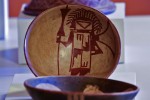 Colombia formally applied for repatriation of the artifacts to the Spanish cultural and law enforcement authorities in 2012. While the wheels of justice were slowly grinding, the Colombian Institute of Anthropology and History sent an archaeologist who examined the seized objects in the museum. His findings confirmed those of the Museum of the Americas’ experts that 691 of the 894 pieces seized originated in Colombia.
Colombia formally applied for repatriation of the artifacts to the Spanish cultural and law enforcement authorities in 2012. While the wheels of justice were slowly grinding, the Colombian Institute of Anthropology and History sent an archaeologist who examined the seized objects in the museum. His findings confirmed those of the Museum of the Americas’ experts that 691 of the 894 pieces seized originated in Colombia.
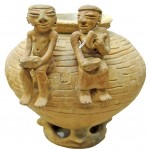 On June 24th of this year, a Spanish High Court ruled that the artifacts were Colombian cultural patrimony and thus should be immediately repatriated. The police picked up the 681 pieces from the museum and delivered them to the Colombian government via its ambassador in Madrid. The formal exchange being done, the Colombian ambassador asked the Museum of the Americas to keep them while arrangements were made for their return. An ICANH expert was on site to assess condition and help with the painstaking process of packing fragile artifacts for shipment across the Atlantic.
On June 24th of this year, a Spanish High Court ruled that the artifacts were Colombian cultural patrimony and thus should be immediately repatriated. The police picked up the 681 pieces from the museum and delivered them to the Colombian government via its ambassador in Madrid. The formal exchange being done, the Colombian ambassador asked the Museum of the Americas to keep them while arrangements were made for their return. An ICANH expert was on site to assess condition and help with the painstaking process of packing fragile artifacts for shipment across the Atlantic.
On Monday representatives from both countries took part in a repatriation ceremony in Bogotá.
The deputy attorney general of Colombia, Jorge Fernando Perdomo, said that after seeing these works “the efforts made by the entities” to recover the archaeological treasure give them added value.
“We have repatriated a museum which was abroad and which returns to Colombia to strengthen the historic identity of the country”, he said.
Perdomo thanked the Spanish government for the police work involved in seizing the items and for their return.
The director of the Colombian Anthropology and History Institute, Fabian Sanabria, announced that it was preparing an extensive exhibition for next year when the artifacts are to go on display.
Thank you for such a great article. It doesn’t surprise though. You always do a fantastic job.